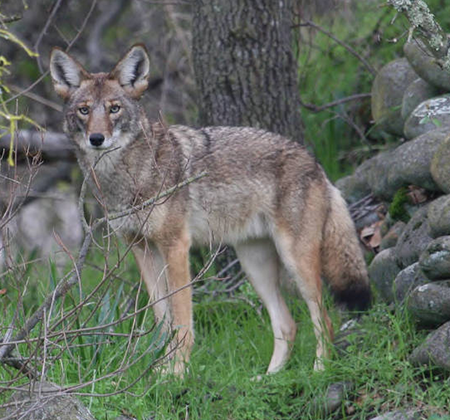
I've been listening to the wonderful vocalizations of the coyotes that live near me all year, and lately on my woods walks I've been seeing their scat laden with berries. Coyotes are amazing. They are very intelligent and can adapt to almost any habitat, from open fields to dense forests to urban landscapes. Though native to North America they did not arrive in Maine until the 1930s after the demise of the wolf population when they could expand their range.
Eastern coyotes are larger and more colorful than western coyotes. In Maine, coyotes adults weigh 30 to 35 pounds on average, with the males weighing in heavier than the females. Western coyotes average 20-25 pounds. The coats of Maine's coyotes are most often a mix of tan, black, white, and grey, but can range from a reddish-tan to black. Their coat has a thick underfur for warmth and an overcoat of long guard hairs that shed rain and snow. Can you see the "coyote cape" in the photo above? Look at the top of the back just behind the shoulders. The cape is outlined in black. The cape is an adaptation that further aids in shedding rain and snow.
Coyotes benefit us by keeping rodent populations in check. As opportunists, they eat a variety of small mammals that include mice, rats, woodchucks, and squirrels. They will also eat snakes, frogs, and fish. During the summer and autumn, they add berries, fruits, and grasses to their diet, and as scavengers will eat the remains (carcasses) of animals they find at any time of year. During the winter when the snow is deep coyotes will hunt deer relay-style in pairs or small family groups.
Coyote pairs share the work of raising their pups, though it is the female that digs or finds the den sites. Multiple dens are used and the young are moved frequently for their safety - to keep them from being detected and to provide a fresh, clean den for their health. Pups are born in late March through May with an average litter size of four. By two to three weeks of age, they emerge from the den and eat regurgitated food. By six months they are almost full grown and are taught to hunt. By eight months the juveniles are independent and disperse. If food sources are plentiful they may stay nearby, if not they will seek new territory. On average coyotes live about 6 years.
Learn more about coyotes:
Photo courtesy of the United States Fish and Wildlife Service.
|